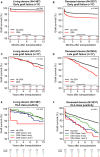Differential effects of donor-specific HLA antibodies in living versus deceased donor transplant
- PMID: 29464832
- PMCID: PMC6175247
- DOI: 10.1111/ajt.14709
Differential effects of donor-specific HLA antibodies in living versus deceased donor transplant
Abstract
The presence of donor-specific anti-HLA antibodies (DSAs) is associated with increased risk of graft failure after kidney transplant. We hypothesized that DSAs against HLA class I, class II, or both classes indicate a different risk for graft loss between deceased and living donor transplant. In this study, we investigated the impact of pretransplant DSAs, by using single antigen bead assays, on long-term graft survival in 3237 deceased and 1487 living donor kidney transplants with a negative complement-dependent crossmatch. In living donor transplants, we found a limited effect on graft survival of DSAs against class I or II antigens after transplant. Class I and II DSAs combined resulted in decreased 10-year graft survival (84% to 75%). In contrast, after deceased donor transplant, patients with class I or class II DSAs had a 10-year graft survival of 59% and 60%, respectively, both significantly lower than the survival for patients without DSAs (76%). The combination of class I and II DSAs resulted in a 10-year survival of 54% in deceased donor transplants. In conclusion, class I and II DSAs are a clear risk factor for graft loss in deceased donor transplants, while in living donor transplants, class I and II DSAs seem to be associated with an increased risk for graft failure, but this could not be assessed due to their low prevalence.
Keywords: alloantibody; clinical research/practice; graft survival; kidney failure/injury; kidney transplantation; kidney transplantation/nephrology; living donor.
© 2018 The Authors. American Journal of Transplantation published by Wiley Periodicals, Inc. on behalf of The American Society of Transplantation and the American Society of Transplant Surgeons.
Figures



References
-
- Wolfe RA, Ashby VB, Milford EL, Ojo AO, Ettenger RE, Agodoa LYC, et al. Comparison of mortality in all patients on dialysis, patients on dialysis awaiting transplantation, and recipients of a first cadaveric transplant. N Engl J Med. 1999;341(23):1725‐1730. - PubMed
-
- Sayegh MH, Carpenter CB. Transplantation 50 years later–progress, challenges, and promises. N Engl J Med. 2004;351(26):2761‐2766. - PubMed
-
- Brenner H, Opelz G, Gondos A, Do B. Kidney graft survival in Europe and the United States: strikingly different long‐term outcomes. Transplantation. 2013;95(2):267‐274. - PubMed
-
- Chapman JR, O'Connell PJ, Nankivell BJ. Chronic renal allograft dysfunction. J Am Soc Nephrol. 2005;16(10):3015‐3026. - PubMed
Publication types
MeSH terms
Substances
LinkOut - more resources
Full Text Sources
Other Literature Sources
Medical
Research Materials

